
Rhetoric and Gender in the Restoration and Early Eighteenth Century Theater PDF
Preview Rhetoric and Gender in the Restoration and Early Eighteenth Century Theater
Georgia State University ScholarWorks @ Georgia State University English Dissertations Department of English 5-3-2007 Low Brows and High Profiles: Rhetoric and Gender in the Restoration and Early Eighteenth Century Theater Elizabeth Anne Tasker Follow this and additional works at:https://scholarworks.gsu.edu/english_diss Part of theEnglish Language and Literature Commons Recommended Citation Tasker, Elizabeth Anne, "Low Brows and High Profiles: Rhetoric and Gender in the Restoration and Early Eighteenth Century Theater." Dissertation, Georgia State University, 2007. https://scholarworks.gsu.edu/english_diss/18 This Dissertation is brought to you for free and open access by the Department of English at ScholarWorks @ Georgia State University. It has been accepted for inclusion in English Dissertations by an authorized administrator of ScholarWorks @ Georgia State University. For more information, please [email protected]. LOW BROWS AND HIGH PROFILES: RHETORIC AND GENDER IN THE RESTORATION AND EARLY EIGHTEENTH CENTURY THEATER by ELIZABETH TASKER Under the Direction of Lynée Lewis Gaillet ABSTRACT The Restoration and early eighteenth century theaters of London formed an important mixed-gender rhetorical venue, which was acutely focused on the age-old “querrelle des femmes” (or woman question). The immediate popularity of the newly opened Restoration theaters, the new practice of casting actresses rather than actors in female roles, and the libertine social climate of London from 1660 to the early 1700s created a unique rhetorical situation in which women openly participated as speakers and audience members. Through a methodology combining genre study, feminist historiography, performance theory, Bitzer’s rhetorical situation, and Habermas’ notion of the public sphere, this dissertation reclaims the Restoration theatre as one of the earliest public, secular, mixed-gender rhetorical venues in the English-speaking world. London theater of the Restoration and the early eighteenth century presents a feminist kairos for rereading and revisioning the actress from object to subject, from passive receiver to deliverer of performative rhetoric. Overall, the attention given to issues of femaleness in the plays of this period exceeds that of preceding and subsequent periods. The novelty of the actresses, as well as disillusionment with the male-dominated government and system of patriarchy, were surely the major contributing factors that led to the female focus on stage. This phenomenon of female rhetoric also reflects the charisma, elocutionary skill, and visual rhetoric of the best female performers of the period, including: Nell Gwyn, Mary Saunderson Betterton, Elizabeth Barry ,Anne Bracegirdle, Susannah Mounfort Verbruggen, Anne Oldfield; and Lavinia Fenton, all of whom are discussed from a rhetorical perspective in this dissertation. INDEX WORDS: Restoration theater, Restoration actresses, Eighteenth century actresses, historical rhetoric, theater history, rhetoric of drama, rhetoric and performance, Elizabeth Barry, Nell Gwynn, Susannah Mountfort, Susannah Verbruggen, Anne Bracegirdle, Anne Oldfield, Lavinia Fenton, feminist historical rhetoric LOW BROWS AND HIGH PROFILES: RHETORIC AND GENDER IN THE RESTORATION AND EARLY EIGHTEENTH CENTURY THEATER by ELIZABETH TASKER A Dissertation Submitted in Partial Fulfillment of the Requirements for the Degree of Doctor of Philosophy in the College of Arts and Sciences Georgia State University 2007 Copyright by Elizabeth Anne Tasker 2007 LOW BROWS AND HIGH PROFILES: RHETORIC AND GENDER IN THE RESTORATION AND EARLY EIGHTEENTH CENTURY THEATER by ELIZABETH TASKER Major Professor: Lynée Lewis Gaillet Committee: Lynée Lewis Gaillet Tanya Caldwell Beth Burmester Electronic Version Approved: Office of Graduate Studies College of Arts and Sciences Georgia State University May 2007 iv To Eva, Ruby, and Bubbles, my two grandmothers and my great aunt, three strong women who each left their unique rhetorical imprint on this earth. v ACKNOWLEDGMENTS Thank you to my family for your tremendous support and patience over the past five and a half years. Words cannot fully express my gratitude. I will make it up to you in deeds. Also, many thanks to my dissertation committee, especially to my advisor and mentor, Lynée Gaillet Lewis. vi TABLE OF CONTENTS ACKNOWLEDGMENTS.........................................................................................v LIST OF FIGURES................................................................................................viii DEAR READERS,....................................................................................................1 CHAPTERS 1. CONTEXTS: HISTORY, RHETORIC, AND DRAMA..................................3 Fissuring the Monolith......................................................................................3 Methodology for Treating Theatre as Rhetoric..............................................17 Theatrical Sub-periods....................................................................................43 2. FINDING VOICE: FEMALE RHETORIC ON THE RESTORATION STAGE............................................................................................................45 The Female Question......................................................................................50 Restoration Audiences and Critics..................................................................53 Performing the Restoration’s Rhetoric of Gender..........................................58 Re-visioning Restoration Actresses................................................................72 3. IN THE SPOTLIGHT: FEMALE RHETORIC ON THE POST- RESTORATION STAGE...............................................................................91 Shifting Power, Changing Ideology................................................................93 Turn-of-the-century Audiences and Anti-theatrical Influences......................97 Performing Sexuality, Suffering, and Difference.........................................102 Revisioning Actresses in an Era of Change..................................................112 vii 4. A NEW VIRTUE: FEMALE RHETORIC ON THE EARLY GEORGIAN STAGE..........................................................................................................145 Bourgeois Ideology, Politeness, and Shifting Symbolism............................146 Performing Female Rhetoric in an Age of Decorum....................................150 Revisioning Actresses of the Early Georgian Period....................................154 5. DRAMATIC PERFORMANCE AS A RHETORIC OF GENDER............160 WORKS CITED....................................................................................................164 Historic Sources............................................................................................164 Contemporary Sources..................................................................................170
Description: